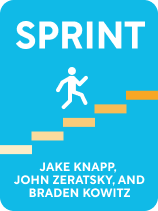

This article is an excerpt from the Shortform book guide to "Sprint" by Jake Knapp, John Zeratsky, and Braden Kowitz. Shortform has the world's best summaries and analyses of books you should be reading.
Like this article? Sign up for a free trial here.
What is a design sprint solution sketch? What are the steps in creating a solution sketch?
According to Jake Knapp’s Design Sprint process, after the first day of your sprint workshop, you should next conduct the design creation phase, when designers create sketches and models of the best ideas generated on day one. Knapp provides four key steps for creating effective solution sketches.
Keep reading to learn Knapp’s four steps for creating design sprint solution sketches.
The Design Sprint & Creating Solution Sketches
According to Sprint authors Jake Knapp, John Zeratsky, and Brian Kowitz, you should focus on creating a design sprint solution sketch on Tuesday (i.e. the second day of your sprint workshop). In developing this timeline, the authors’ were in part inspired by IDEO’s design thinking workshops. The Design Sprint follows many of the same principles as design thinking: a process designers use to understand the needs of users, solve design problems, and develop products and services.
Like the Design Sprint, design thinking is an iterative process. This involves creating many versions of the same idea and improving your idea using the information you gain from each iteration. Ultimately, design thinking can be broken down into two parts: identifying a problem and developing a solution.
A design thinking process cycles through four phases, which repeat as many times as is necessary to create the best product.
- First, there is the observation phase, when designers gather information about the customers who’ll use their product.
- Second is the idea generation phase, when designers come up with as many solutions as they can to the problem they want to solve with their product.
- Third is the prototype phase, when designers create solution sketches and models of the best ideas generated in the second phase.
- Fourth is the testing phase, when designers have their target customers test the prototype product and give feedback.
Knapp suggests two steps for creating your design sprint solution sketch—gather inspiration for your idea and create a drawing of your best design idea.
First, Gather Inspiration
The authors argue that every good idea builds off of what came before, so you’ll start on Tuesday morning by gathering inspiration from other products and services. Every team member should make a list of products, either from your company or from another, that have features you can emulate in your own product. In short presentations, each person will explain the contents of their lists. As people present, record every product mentioned with a little sketch and blurb explaining what inspiration it has to offer.
(Shortform note: Drawing from other people’s products to create your design sprint solution sketch may feel strange. It may even feel like stealing. To get better as a designer, however, you have to study the products you admire to understand what makes them so successful. If you synthesize the successful elements you identify with your own ideas and experiences, you can create an original product with its own unique value. This doesn’t mean copying or even refashioning. It means adding your perspective to an existing conversation.)
The 4 Steps of a Solution Sketch
Once you’ve reviewed your outside examples, it’s time to start drawing concrete designs for your product. Knapp, Zeratsky, and Kowitz outline a four-part process that each team member will complete individually on Tuesday afternoon. You will refine your ideas more with each part.
| The Perils of Group Brainstorming After holding many workshops experimenting with group brainstorming methods and getting unimpressive results, Knapp found that people generate their best ideas individually. Other research supports this conclusion: When brainstorming is done in a group setting with no structure, people come up with fewer, less unique, and less practical ideas than they do when working alone. In order to collaborate effectively, you need to know when to generate ideas separately and when to come back together. You might choose to only work as a group when you’re ready to narrow down your individually-generated ideas into a list of the best options for the project’s purpose. Knapp, Zeratsky, and Kowitz demonstrate this by having you first work alone during the design drawing process and then instructing you to critique the designs as a team. |
Step 1: Review Information and Take Notes
For 20 minutes, the authors suggest you silently review the information collected on the whiteboards, which you should have already prepared during day one of your sprint workshop. Write down any details from your flowchart, your goal, your questions, and the list of inspirational examples that may contribute to your product’s design. These notes will be a reference of what you’ve developed so far as a group, keeping you aligned with the team’s vision as you draw out your design sprint solution sketches.
(Shortform note: There are many different note-taking styles you can adapt to fit your needs during this step. For example, mind mapping can be a useful method for connecting ideas, helping you organize the pieces of information you’ve learned relationally. The Cornell method can help you summarize central ideas and organize them thematically. When you’re taking notes on the materials you’ve created for your sprint, organize the information in whatever way works best for you.)
Step 2: Put Your Thoughts on Paper
Now, the authors say, it’s time to start generating ideas for your product design with some loose brainstorming. For another 20 minutes, write or draw any thoughts you have about the product in the form of diagrams, doodles, and text—as the thoughts come, include them in your design sprint solution sketch page.
(Shortform note: In Getting Things Done, David Allen shares some useful tips for brainstorming. First, don’t criticize or limit the ideas you put on paper. This will only stifle your creativity. The quantity of your ideas matters more than the quality at this stage. Second, don’t worry about neatly organizing your ideas during this part of the process. The goal should be getting ideas out of your head and onto the page.)
Step 3: Create 60-Second Design Drawings
Now, the authors state, fold a sheet of paper into eight sections. In each section, take 60 seconds to draw a rough design solution sketch of your product or a component of the product. It’s helpful to do multiple variations of the same idea. These should be more specific than anything you generated in Part 2, but they still don’t have to be polished. This step is meant to challenge you to quickly think of multiple design approaches to the same product.
(Shortform note: The iterative process of this activity uses the same principles as design thinking on a much smaller scale. The more versions you create of an idea, the more you learn, and the better your final product will be.)
Step 4: Finalize Your Best Design Idea
Create a final design solution sketch of your idea on three sticky notes in the form of a storyboard. Each panel should show a step required to use the product or a different feature of your design. This should be the best product design you can come up with.
(Shortform note: Drawing your ideas can be helpful in a number of ways. For one, it’s easier to draw some ideas than it is to describe them. Also, drawings are also more ambiguous than written or verbal descriptions, so they introduce the possibility for multiple interpretations of a design. This can lead to new ideas and innovations as you consider your design from someone else’s perspective. Finally, drawing engages a different part of your brain than language-based communication, opening you up to new avenues of creativity.)

———End of Preview———
Like what you just read? Read the rest of the world's best book summary and analysis of Jake Knapp, John Zeratsky, and Braden Kowitz's "Sprint" at Shortform.
Here's what you'll find in our full Sprint summary:
- How to build and test a prototype in just a five-day work week
- The step-by-step processes for planning and completing a sprint
- How to conduct one-on-one interviews with your customers






